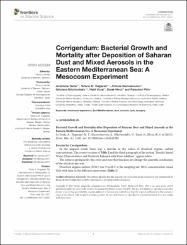Corrigendum: Bacterial growth and mortality after deposition of saharan dust and mixed aerosols in the eastern mediterranean sea: A mesocosm experiment

View/
Date
2017Author
Tsiola, AnastasiaTsagaraki, Tatiana M.
Giannakourou, Antonia
Nikolioudakis, Nikolaos
Yücel, Nebil
Herut, Barak
Pitta, Paraskevi
Metadata
Show full item recordCitation
Tsiola, A., Tsagaraki, T.M., Giannakourou, A., (...), Herut, B., Pitta, P. (2017). Corrigendum: Bacterial growth and mortality after deposition of saharan dust and mixed aerosols in the eastern mediterranean sea: A mesocosm experiment. Frontiers in Marine Science, 4(FEB), 57. doi: 10.3389/FMARS.2017.00057Abstract
The impact of viral lysis and grazing by flagellates on bacterioplankton production was assessed during a mesocosm experiment in the Eastern Mediterranean Sea, in response to Saharan dust (SD) vs. mixed aerosols (A) addition. The results highlight a positive effect on bacterial abundance, production and growth rate (similar to 1.2, similar to 2.4, and similar to 1.9-fold higher than the controls) in both SD and A, which was also confirmed by the increased portion of high DNA content bacteria (up to 48% of the bacterial community). Lytic viral production and the portion of bacterial production lost due to viral lysis were lower in SD and A after dust addition than in the controls (0.33 +/- 0.17 x 10(6) virus-like particles mL(-1) h(-1) and 6 +/- 4%, respectively). Potential ingestion rate of bacteria by flagellates increased upon dust enrichment, but did not differ between mesocosms. Larger predators possibly down regulated flagellate abundance, and the calculated portion of bacterial production lost due to flagellate grazing was probably an artifact. Higher frequency of lysogenic cells in A compared to SD and the controls four days after dust addition may reflect faster phosphorus limitation in A, due to receiving less dissolved inorganic phosphorus and more dissolved inorganic nitrogen than SD.















